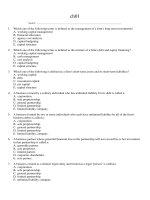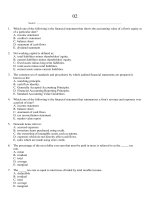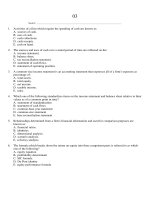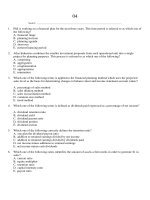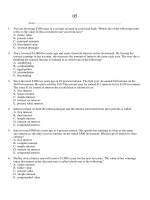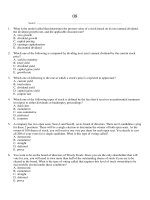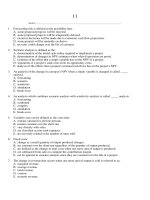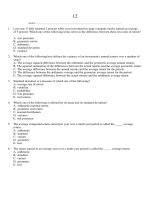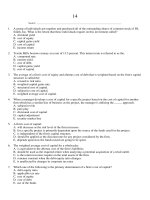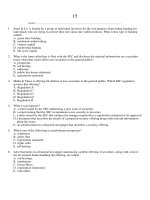Fundamentals of corporate finance brealey chapter 05 valuing bond
Bạn đang xem bản rút gọn của tài liệu. Xem và tải ngay bản đầy đủ của tài liệu tại đây (339.84 KB, 17 trang )
Solutions to Chapter 5
Valuing Bonds
Note: Unless otherwise stated, assume all bonds have $1,000 face (par) value.
1.
2.
a.
The coupon payments are fixed at $60 per year.
Coupon rate = coupon payment/par value = 60/1000 = 6%, which remains
unchanged.
b.
When the market yield increases, the bond price will fall. The cash flows are
discounted at a higher rate.
c.
At a lower price, the bond’s yield to maturity will be higher. The higher
yield to maturity on the bond is commensurate with the higher yields
available in the rest of the bond market.
d.
Current yield = coupon payment/bond price. As coupon payment remains the
same and the bond price decreases, the current yield increases.
When the bond is selling at a discount, $970 in this case, the yield to maturity is
greater than 6%. We know that if the discount rate were 6%, the bond would sell at par.
At a price below par, the YTM must exceed the coupon rate.
Current yield equals coupon payment/bond price, in this case, 60/970. So current yield
is also greater than 6%.
3.
Coupon payment = .08 x 1000 = $80
Current yield = 80/bond price = .075
Therefore, bond price = 80/.075 = $1,066.67
4.
Par value is $1000 by assumption.
Coupon rate = $75/$1000 = .075 = 7.5%
Current yield = $75/$950 = .0789 = 7.89%
Yield to maturity = 8.6% [n = 6; PV= (-)950; FV = 1000; PMT = 75)
5.
To sell at par, the coupon rate must equal yield to maturity. Since Circular bonds
yield 8.6%, this must be the coupon rate.
5-1
Copyright © 2006 McGraw-Hill Ryerson Limited
6.
a.
Current yield = annual coupon/price = $80/1050 = .0762 = 7.62%.
b.
YTM = 7.2789%. On the calculator, enter PV = (-)1050,
FV = 1000, n = 10, PMT = 80, compute i.
7.
When the bond is selling at par, its yield to maturity equals its coupon rate. This
firm’s bonds are selling at a yield to maturity of 9.25%. So the coupon rate on the
new bonds must be 9.25% if they are to sell at par.
8.
The current bid yield on the bond was 4.60%. To buy the bond, investors pay the
ask price. The investor would pay 102.52 percent of par value. With $1,000 par
value, this means paying $1,025.2 to buy a bond.
9.
Coupon payment = interest = .05 × 1000 = 50
Capital gain = 1100 – 1000 = 100
Rate of return = = = .15 = 15%
10.
Tax on interest received = tax rate × interest = .3 × 50 = 15
After-tax interest received = interest – tax = 50 – 15 = 35
Fast way to calculate:
After-tax interest received = (1 – tax rate) × interest = (1 – .3)× 50 = 35
Tax on capital gain = .5 × .3 × 100 = 15
After-tax capital gain = 100 – 15 = 85
Fast way to calculate:
After-tax capital gain = (1 – tax rate) × capital gain = (1 – .5×.3)×100 = 85
After-tax rate of return =
= = .12 = 12%
11.
Bond 1
year 1: PMT = 80, FV = 1000, i = 10%, n = 10; Compute PV0 = $877.11
year 2: PMT = 80, FV = l000, i = 10%, n = 9; Compute PV1 = $884.82
Rate of return = = .10 = 10%
Bond 2
year 1: PMT = 120, FV = 1000, i = 10%, n = 10; Compute PV0 = $1122.89
year 2: PMT = 120, FV = l000, i = 10%, n = 9; Compute PV1 =$1115.18
5-2
Copyright © 2006 McGraw-Hill Ryerson Limited
Rate of return = = .10 = 10%
Both bonds provide the same rate of return.
12.
Accrued interest=
Coupon payment ×
= 22.5 × = $16.63
Dirty bond price= clean bond price + accrued interest = $990+ $16.63= $1006.63
The quoted clean price is $990. The bond pays semi-annual interest. The last $22.5
coupon was paid on March 1, 2011, and the next coupon will be paid on September 1,
2011. The number of days from the last coupon payment to the purchase date is 136
(from March 1 to July 15) and the total number of days in the coupon period is 184
(from March 1 to September 1). The accrued interest is $16.63, and the total cost of
buying one bond is $1006.63.
13.
a.
b.
If YTM = 8%, price will be $1000.
Rate of return =
= = .0286 = 2.86%
c.
Real return = – 1
=
14.
15.
1.0286
– 1 = –.001359, or about – .136%
1.03
a.
With a par value of $1000 and a coupon rate of 8%, the bondholder receives 2
payments of $40 per year, for a total of $80 per year.
b.
Assume it is 9%, compounded semi-annually. Per period rate is 9%/2, or 4.5%
Price = 40 × annuity factor(4.5%, 18 years) + 1000/1.04518 = $939.20
c.
If the yield to maturity is 7%, compounded semi-annually, the bond will sell
above par, specifically for $1,065.95:
Per period rate is 7%/2 = 3.5%
Price = 40 × annuity factor(3.5%, 18 years) + 1000/1.03518 = $1,065.95
On your calculator, set n = 30, FV =1000, PMT = 97.5.
a.
b.
Set PV = (-)900 and compute the interest rate to find that YTM = 10.89%
Set PV = (-)1000 and compute the interest rate to find that YTM = 9.75%.
5-3
Copyright © 2006 McGraw-Hill Ryerson Limited
c.
16.
17.
Set PV = (-)1100 and compute the interest rate to find that YTM = 8.794%
On your calculator, set n=60, FV=1000, PMT=48.75.
a.
Set PV = (-)900 and compute the interest rate to find that the (semiannual) YTM
=5.443%. The bond equivalent yield to maturity is therefore 5.443 × 2 =
10.886%.
b.
Set PV = (-)1000 and compute the interest rate to find that YTM = 4.875%. The
annualized bond equivalent yield to maturity is therefore 4 × 2= 9.75%.
c.
Set PV = (-)1100 and compute the interest rate to find that YTM = 4.399%. The
annualized bond equivalent yield to maturity is therefore 4.399 × 2 = 8.798%.
In each case we solve this equation for the missing variable:
Price= 1000/(1 + YTM)maturity
Price
300
300
385.54
Maturity (years)
30.0
15.64
10.0
YTM
4.095%
8.0%
10.0%
Alternatively the problem can be solved using a financial calculator:
Solving the first question: PV = (-)300, PMT = 0, n = 30, FV = 1000, and
compute i.
18.
PV of perpetuity = coupon payment/rate of return.
PV = C/r = 60/.06 = $1000
If the required rate of return is 10%, the bond sells for:
PV = C/r = 60/.1 = $600
19.
Because current yield = .098375, bond price can be solved from: 90/Price = .098375,
which implies that price = $914.87. On your calculator, you can now enter: i = 10;
PV = (-)914.87; FV = 1000; PMT = 90, and solve for n to find that n =20 years.
20.
Assume that the yield to maturity is a stated rate. Thus the per period rate is 7%/2 or
3.5%. We must solve the following equation:
5-4
Copyright © 2006 McGraw-Hill Ryerson Limited
PMT × annuity factor(3.5%, 18 periods) + 1000/(1.035)18 = $1065.95
To solve, use a calculator to find the PMT that makes the PV of the bond cash flows
equal to $1065.95. You should find PMT = $40. The coupon rate is 2×40/1000 = 8%.
21.
NOTE: Typo in the text! The yield to maturity on the bond at issue should be 6.5%, not
65%!! Also, the solution at the end of textbook does not match this question. In
fact, it is the solution for the case where the bond’s yield to maturity at issue
was 8%. See below to get the solution in the back of the textbook.a. Assume
that the bonds were issued at par value. With a yield to maturity of 6.5% at
issue, the coupon rate must be 6.5%. The semi-annual coupon payment is
0.065/2 × $1,000 = $32.50 Now, the price is
32.50 × Annuity factor(7%, 16 periods) + 1000/1.0716 = $645.75
b.
The investors pay $645.75 for the bond. They expect to receive the promised
coupons plus $800 at maturity. We calculate the yield to maturity based on these
expectations:
32.50 × Annuity factor(i, 16 periods) + 800/(1 + i)16 = $645.75
which can be solved on the calculator to show that i =5.97%. On an annual
basis, this 2×5.97% or 11.94% [n = 16; PV = (-)645.75; FV = 800; PMT =
32.50]
ALTERNATE SOLUTION: If the yield to maturity at issue was 8%, then you get the
following answers (this corresponds to the solution found in Appendix B at the
back of the book)
a.
Assume that the bonds were issued at par value. With a yield to maturity of 8%
at issue, the coupon rate must be 8%. The semi-annual coupon payment is
0.08/2 × $1,000 = $40 Now, the price is
40 × Annuity factor(7%, 16 periods) + 1000/1.0716 = $716.60
b.
The investors pay $716.60 for the bond. They expect to receive the promised
coupons plus $800 at maturity. We calculate the yield to maturity based on these
expectations:
49 × Annuity factor(i, 16 periods) + 800/(1 + i)16 = $716.60
which can be solved on the calculator to show that i =6.03%. On an annual
basis, this 2×6.03% or 12.06% [n = 16; PV = (-)716.60; FV = 800; PMT = 40]
22.
a.
Today, at a price of 980 and maturity of 10 years, the bond’s yield to maturity is
8.3% (n = 10, PV = (-) 980, PMT = 80, FV = 1000).
5-5
Copyright © 2006 McGraw-Hill Ryerson Limited
In one year, at a price of 1050 and remaining maturity of 9 years, the bond’s
yield to maturity is 7.23% (n = 9, PV = (-) 1050, PMT = 80, FV = 1000).
b.
23.
Rate of return =
= 15.31%
Assume the bond pays an annual coupon. The answer is:
PV0 = $935.82 (n = 10, PMT = 80, FV = 1000, i = 9)
PV1 = $884.82 (n = 9, PMT = 80, FV = 1000, i = 10)
Rate of return =
80 + 884.82 − 935.82
= 3.10%
935.82
If the bond pays coupons semi-annually, the solution becomes more complex. First,
decide if the yields are effective annual rates or APRs. Second, make an assumption
regarding the rate at which the first (mid-year) coupon payment is reinvested for the
second half of the year. Your assumptions will affect the calculated rate of return on
the investment. Here is one possible solution:
Assume that the yields are APR and the yield changes from 9% to 10% at the end of
the year. The bond prices today and one year from today are:
PV0 = $934.96 (n = 2 × 10 = 20, PMT = 80/2 = 40, FV = 1000, i = 9/2 = 4.5)
PV1 = $883.10 (n = 2 × 9 = 18, PMT = 80/2 = 40, FV = 1000, i = 10/2 = 5)
Assuming that the yield doesn’t increase to 10% until the end of year, the $40 midyear coupon payment is reinvested for half a year at 9%, compounded monthly. Its
future value at the end of the year is: $40 × (1.045) = $41.80 and the rate of return on
the bond investment is:
Rate of return = = 3.20%
24.
The price of the bond at the end of the year depends on the interest rate at that time.
With one year until maturity, the bond price will be $ 1065/(1 + r).
a.
Price = 1065/1.06 = $1004.72
Return = [65 + (1004.72 – 1000)]/1000 = .06972 = 6.972%
b.
Price = 1065/1.08 = $986.11
Return = [65+ (986.11 – 1000)]/1000 = .05111 = 5.111%
c.
Price = 1065/1.10 = $968.18
Return = [65 + (968.18 – 1000)]/1000 = .0332 = 3.32%
5-6
Copyright © 2006 McGraw-Hill Ryerson Limited
25.
The bond price is originally $549.69. (On your calculator, input n = 30, PMT =
40, FV =1000, and i = 8%.) After one year, the maturity of the bond will be 29
years and its price will be $490.09. (On your calculator, input n = 29, PMT = 40,
FV = 1000, and i = 9%.) The rate of return is therefore [40 + (490.09 –
549.69)]/549.69 = –.0357 = –3.57%.
26.
a.
Annual coupon = .08 × 1000 = $80.
Total coupons received after 5 years = 5 × 80 = $400
Total cash flows, after 5 years = 400 + 1000 = $1400
Rate of return =
b.
()
1/5
– 1 = .075 = 7.5%
Future value of coupons after 5 years
= 80 × future value factor(1%, 5 years) = 408.08
Total cash flows, after 5 years = 408.08 + 1000 = $1408.8
Rate of return =
c.
()
1/5
– 1 = .0763 = 7.63%
Future value of coupons after 5 years
= 80 × future value factor(8.64%, 5 years) = 475.35
Total cash flows, after 5 years = 475.35 + 1000 = $1475.35
Rate of return =
27.
()
1/5
– 1 = .0864 = 8.64%
To solve for the rate of return using the YTM method, find the discount rate that makes
the original price equal to the present value of the bond’s cash flows:
975 = 80 × annuity factor( YTM, 5 years ) + 1000/(1 + YTM)5
Using the calculator, enter PV = (-)975, n = 5, PMT = 80, FV = 1000 and compute i.
You will find i = 8.64%, the same answer we found in 26 (c).
28. a.
False. Since a bond's coupon payments and principal are fixed, as interest rates
rise, the present value of the bond's future cash flow falls. Hence, the bond
price falls.
Example: Two-year bond 3% coupon, paid annual. Current YTM = 6%
Price = 30 × annuity factor(6%, 2) + 1000/(1 + .06)2 = 945
If rate rises to 7%, the new price is:
5-7
Copyright © 2006 McGraw-Hill Ryerson Limited
Price = 30 × annuity factor(7%, 2) + 1000/(1 + .07)2 = 927.68
29.
b.
False. If the bond's YMT is greater than its coupon rate, the bond must sell at a
discount to make up for the lower coupon rate. For an example, see the bond in
a. In both cases, the bond's coupon rate of 3% is less than its YTM and the bond
sells for less than its $1,000 par value.
c.
False. With a higher coupon rate, everything else equal, the bond pays more
future cash flow and will sell for a higher price. Consider a bond identical to
the one in a. but with a 6% coupon rate. With the YTM equal to 6%, the bond
will sell for par value, $1,000. This is greater the $945 price of the otherwise
identical bond with a 3% coupon rate.
d.
False. Compare the 3% coupon bond in a with the 6% coupon bond in c. When
YTM rises from 6% to 7%, the 3% coupon bond's price falls from $945 to
$927.68, a -1.8328% decrease (= (927.68 - 945)/945). The otherwise identical
6% bonds price falls to 981.92 (= 60 × annuity factor(7%, 2) + 1000/(1 + .07)2)
when the YTM increases to 7%. This is a -1.808% decrease (= 981.92 1000/1000), which is slightly smaller. The prices of bonds with lower coupon
rates are more sensitivity to changes in interest rates than bonds with higher
coupon rates.
e.
False. As interest rates rise, the value of bonds fall. A 10 percent, 5 year Canada
bond pays $50 of interest semi-annually (= .10/2 × $1,000). If the interest rate is
assumed to be compounded semi-annually, the per period rate of 2% (= 4%/2)
rises to 2.5% (=5%/2). The bond price changes from:
Price = 50 × annuity factor(2%, 2×5) + 1000/(1 + .02)10 = $1,269.48
to:
Price = 50 × annuity factor(2.5%, 2×5) + 1000/(1 + .025)10 = $1,218.80
The wealth of the investor falls 4% (=$1,218.80 - $1,269.48/$1,269.48).
Internet: Using historical yield-to-maturity data from Bank of Canada
Tips: Students will need to read the instructions on how to put the data into a
spreadsheet. They will want to save the data in CSV format so that it will be easily
moved into the spreadsheet. The data will be automatically put into Excel if you
access the website with Internet Explorer. Watch that the headings for the columns of
data in your spreadsheet aren’t out of line (we found that the Government of Canada
bond yield heading took two columns, displacing the other two headings – the data
itself were in the correct columns).
Expected results: Long-term Government of Canada bonds have the lowest yield,
followed by the yields for the provincial long bonds and then for the corporate
bonds. The graph of the yields clearly shows the consistent spreads but also how
the level of interest rates varies over time. For an even clearer picture, have the
students pick data from 1990 onward.
5-8
Copyright © 2006 McGraw-Hill Ryerson Limited
Time Series: Low/High/Average
(Accessed November 22, 2008)
Date Range: 2002/07 – 2007/06
'V122544=Government of Canada benchmark bond yields - long-term
'V122517=Average weighted bond yields (Scotia Capital Inc.) - Provincial long-term
'V122518=Average weighted bond yields (Scotia Capital Inc.) - All
corporates - long-term
Yield spread
Yield Spread
(Provincial
(Corporate vs.
Date
V122544 V122517 V122518 vs. Canada)
Canada)
2002/0
7
5.73
6.13
7.19
0.4
1.46
2002/08
5.58
6
6.99
0.42
1.41
2002/09
5.43
5.83
6.84
0.4
1.41
2002/10
5.63
6.05
7.17
0.42
1.54
2002/11
5.58
5.99
6.96
0.41
1.38
2002/12
5.42
5.81
6.73
0.39
1.31
2003/01
5.49
5.92
6.85
0.43
1.36
2003/02
5.46
5.88
6.81
0.42
1.35
2003/03
5.58
6.02
7.06
0.44
1.48
2003/0
4
5.41
5.82
6.7
0.41
1.29
2003/0
5
5.12
5.52
6.35
0.4
1.23
2003/0
6
5.03
5.41
6.22
0.38
1.19
2003/0
7
5.4
5.7
6.48
0.3
1.08
2003/08
5.44
5.79
6.54
0.35
1.1
2003/09
5.23
5.57
6.29
0.34
1.06
2003/10
5.38
5.73
6.39
0.35
1.01
2003/11
5.29
5.63
6.27
0.34
0.98
2003/12
5.2
5.52
6.07
0.32
0.87
2004/0
1
5.23
5.5
6.03
0.27
0.8
2004/0
2
5.09
5.37
5.87
0.28
0.78
2004/0
3
5.04
5.38
5.85
0.34
0.81
2004/0
4
5.31
5.66
6.15
0.35
0.84
2004/0
5
5.32
5.71
6.25
0.39
0.93
2004/0
6
5.33
5.78
6.36
0.45
1.03
2004/0
7
5.29
5.76
6.34
0.47
1.05
2004/0
8
5.15
5.58
6.17
0.43
1.02
2004/0
9
5.04
5.44
6.05
0.4
1.01
5-9
Copyright © 2006 McGraw-Hill Ryerson Limited
2004/1
0
2004/11
2004/12
2005/0
1
2005/0
2
2005/0
3
2005/0
4
2005/0
5
2005/0
6
2005/0
7
2005/0
8
2005/0
9
2005/1
0
2005/11
2005/12
2006/0
1
2006/0
2
2006/0
3
2006/0
4
2006/0
5
2006/0
6
2006/0
7
2006/0
8
2006/0
9
2006/1
0
2006/11
2006/12
2007/0
1
2007/0
2
2007/0
3
2007/0
5
4.9
4.92
5.39
5.29
5.3
5.99
5.88
5.82
0.39
0.39
0.38
0.99
0.98
0.9
4.74
5.14
5.66
0.4
0.92
4.76
5.11
5.62
0.35
0.86
4.77
5.21
5.73
0.44
0.96
4.59
5.04
5.58
0.45
0.99
4.46
4.89
5.46
0.43
1
4.29
4.69
5.2
0.4
0.91
4.31
4.72
5.25
0.41
0.94
4.12
4.52
5.04
0.4
0.92
4.21
4.64
5.15
0.43
0.94
4.37
4.18
4.02
4.82
4.67
4.54
5.34
5.24
5.09
0.45
0.49
0.52
0.97
1.06
1.07
4.2
4.71
5.3
0.51
1.1
4.15
4.67
5.27
0.52
1.12
4.23
4.78
5.37
0.55
1.14
4.57
5.07
5.67
0.5
1.1
4.5
5.01
5.6
0.51
1.1
4.67
5.18
5.81
0.51
1.14
4.45
4.96
5.6
0.51
1.15
4.2
4.69
5.33
0.49
1.13
4.07
4.55
5.18
0.48
1.11
4.24
4.02
4.1
4.7
4.47
4.56
5.33
5.11
5.18
0.46
0.45
0.46
1.09
1.09
1.08
4.22
4.66
5.28
0.44
1.06
4.09
4.53
5.15
0.44
1.06
4.21
4.2
4.64
4.64
5.27
5.38
0.43
0.44
1.06
1.18
5-10
Copyright © 2006 McGraw-Hill Ryerson Limited
4
2007/0
5
2007/0
6
4.39
4.84
5.63
0.45
1.24
4.56
5.07
5.82
0.51
1.26
Average Yield Spread of the provincial bonds over the Canada bonds:0.42%
Average Yield Spread of the corporate bonds over the Canada bonds: 1.09%
We can see that long-term Government of Canada bonds have the lowest yield
over time, followed by the yields for long-term provincial long bonds and then for
the corporate bonds. The graph of the yields clearly shows the consistent spreads
but also how the level of interest rates varies over time. The result makes sense
because YTM of long-term Canada bonds has the lowest risk premium of the
three, followed by YTM of the provincial bonds. YTM of long-term corporate
bonds has larger spreads over Canada bonds because it has much higher default
and liquidity risk than Canada Bonds.
30.
a. Strips pay no interest, only principal. Assume each bond pays $100 principal on the
maturity date
Bond
June 2010
June 2012
June 2015
June 2019
June 2025
Time to Maturity (Years)
1.583
3.583
6.583
10.583
16.583
5-11
Copyright © 2006 McGraw-Hill Ryerson Limited
YTM = (100/Price)1/time to maturity - 1
= (100/96.94)1/1.583 - 1 = .01926
= (100/91.04)1/3.583 - 1 = .02655
= (100/80.58)1/6.583 - 1 = .03334
= (100/65.43)1/10.583 - 1 = .04090
= (100/45.75)1/16.583 - 1 = .04828
b. The term structure (yield curve) is upward sloping.
31.
Price of bond today
= 40 × PVIFA(5%, 3) + 50 × PVIFA(5%,3) × PVIF(5%,3)
+ 60 × PVIFA(5%,3)×PVIF(5%,6) + 1000 × PVIF(5%, 9)
= 108.93 + 117.62 + 121.93 + 644.61 = $993.09
32.
a., b.
Price of each bond at different yields to maturity
Maturity of bond
4 years
8 years
Yield (%)
7
1124.09
8
1000.00
9
897.26
Difference between prices
(YTM=7% vs YTM=9%)
226.83
c.
33.
1033.87
1059.71
1000.00
1000.00
967.60
944.65
66.27
115.06
30 years
The table shows that prices of longer-term bonds respond with more
sensitivity to changes in interest rates. This can be illustrated in a variety of
ways. In the table we compare the prices of the bonds at 7 percent and 9
percent yields. When the yield falls from 9 to 7%, the price of the 30-year
bond increases $226.83 but the price of the 4-year bond only increases
$66.27. Another way to compare the bonds’ sensitivity to changes in the
yield is to look at the percentage change in the prices. For example, with an
increase in the yield from 8 to 9%, the price of the 4-year bond falls
(967.6/1000) –1, or 3.24% but the 30-year bond price falls (897.26/1000) –
1, or 10.27%.
The bond’s yield to maturity will increase from 8.5%, effective annual interest (EAR)
to 8.8%, EAR, when the perceived default risk increases.
6 month interest rate equivalent to 8.5% EAR = (1.085)1/2 – 1 = .041633
6 month interest rate equivalent to 8.8% EAR = (1.088)1/2 – 1 = .043072
Price at AA rating = $978.12 (n = 2×10 = 20, PMT = 80/2 = 40, FV =1000, i =
4.1633)
5-12
Copyright © 2006 McGraw-Hill Ryerson Limited
Price at A rating = $959.36 (n = 2×10 = 20, PMT = 80/2 = 40, FV =1000, i = 4.3072)
The price falls by $18.76 dollars due to the drop in the bond rating and the increase in
the required rate of return.
34.
Internet: Credit spreads on corporate bonds
At www.bondsonline.com/Todays_Market/Corporate_Bond_Spreads.php, the spread for
a 10 year A2/A-rated bond was reported to be “95”, meaning 95 basis points (bp) or .
95%. The spread for a 10 year B2/B-rated bond was 265 bp or 2.65%. As of March 9,
2009 the yield to maturity on a 10 year US Treasury bond was 2.88%. The estimated
required rate of return on each corporate bond is:
Required rate of return = US treasury bond yield to maturity + credit spread
10 year A2/A-rated bond required rate of return = 2.88% + .95% = 3.83%
10 year B2/B-rated bond required rate of return = 2.88% + 2.65% = 5.53%
35.
Internet: Canadian corporate bond yields
Tips: If you click on “Bond Type” it will sort the bonds by type, making it easier to
find a set of corporate bonds. Alternatively, the data in the table can be copied and
pasted into Excel and sorted there. If you sort by type and maturity, it is easier to
get a group of corporate bonds with similar maturity dates. At www.dbrs.com,
type the company name into the search box. If the company is rated, it will be
listed. Click on the name and pick the rating of the subordinated debt (or just the
lowest rating). Find a Government of Canada bond (CANADA FEDGOV) with a
similar maturity date in the bond list. Calculate the yield spread: corporate bond
yield – government bond yield and compare the yields and spread with the
different ratings.
Here’s sample of data taken from the globeinvestor.com bond table and assembled
into a table in Excel. “Spread” in the final column is calculated as the difference
between the corporate bond yield and the corresponding Government of Canada
bond. Federal government bonds could not be found with exactly the same
maturity date for all corporate bonds. So the Federal bond with closest maturity
date was chosen. The BBB rate bonds have the largest spread, between 410 and
466 basis points. The Canadian Tire A low bond spread, 6.47 – 2.06 = 4.06 is a bit
lower than the BBB spread but not by much. By contrast the two AA corporate
5-13
Copyright © 2006 McGraw-Hill Ryerson Limited
bonds (Bank of Montreal and Bank of Nova Scotia) are substantially smaller, only
about 260 basis points.
DBRS
Rating
CANADIAN NATURAL
RESOURCES
METRO INC
LOBLAWS
CANADIAN TIRE
BANK OF MTL
BANK OF NOVA SCOTIA
36.
CORPORATE BONDS
Coupon Coupon
Rate
Freq. Maturity
BBB
BBB
BBB
A low
AA low
AA low
4.95
4.98
7.1
4.95
4.55
4.15
S
S
S
S
S
S
CANADA FEDGOV
Price Yield Maturity
6/1/2015 91.09
10/15/2015 92.08
6/1/2016 104.02
6/1/2015 93.99
8/1/2017 96.52
10/27/2017 98.97
6.72
6.47
6.39
6.12
5.06
5.17
Yield
Spread
2.06
2.06
2.29
2.06
2.51
2.51
4.66
4.41
4.10
4.06
2.55
2.66
6/1/2015
6/1/2015
6/1/2016
6/1/2015
6/1/2017
6/1/2017
YTM = 4%
Real interest rate = 1 + nominal interest rate
= 1.04 - 1 = .0196, or 1.96%
1 + expected rate of inflation 1.02
Real interest rate ≈ nominal interest rate - expected inflation rate = 4% - 2% = 2%
37.
The nominal return is 1060/1000, or 6%. The real return is 1.06/(1 + inflation) – 1.
a.
b.
c.
d.
1.06/1.02 – 1 = .0392 = 3.92%
1.06/1.04 – 1 = .0192 = 1.92%
1.06/1.06 – 1 = 0%
1.06/1.08 – 1 = – .0185 = –1.85%
38. The principal value of the bond will increase by the inflation rate, and since the
coupon is 4% of the principal, it too will rise along with the general level of prices. The total
cash flow provided by the bond will be
1000 × (1 + inflation rate) + coupon rate × 1000 × (1 + inflation rate).
Since the bond is purchased for par value, or $1000, total dollar nominal return is
therefore the increase in the principal due to the inflation indexing, plus coupon
income:
Income = 1000 × inflation rate + coupon rate × 1000 × (1 + inflation rate)
Finally, the nominal rate of return = income/1000.
a.
Nominal return = = .0608
Real return = – 1 = .04
b.
Nominal return = = .0816
Real return = – 1 = .04
c.
Nominal return = = .1024
Real return = – 1 = .04
5-14
Copyright © 2006 McGraw-Hill Ryerson Limited
d.
Nominal return = = .1232
a.
b.
c.
d.
First year income
40x1.02=$40.80
40x1.04=$41.60
40x1.06=$42.40
40x1.08=$43.20
39.
40.
Real return = – 1 = .04
Second year income
1040 x 1.022 = $1082.02
1040 x 1.042 = $1124.86
1040 x 1.062 = $1168.54
1040 x 1.082 = $1213.06
a. YTM = 5.76% (n=15, PV = (-)1048, PMT=62.5, FV=1000)
b. YTC = 6.33% (n=10, PV = (-)1048, PMT=62.5, FV=1100)
41.
a. Current price = 1,112.38 (n=6, i=4.8%, PMT=70, FV=1000)
b. Current call price = 1,137.35 (n=6, i=4.35%, PMT=70, FV=1000)
42.
a. YTM on ABC bond at issue = 5.5% (since sold at par, coupon rate = required rate of
return)
10-year Gov't of Canada bond yield at issue
= ABC bond YTM - credit spread = 5.5% - .25% = 5.25%
Required yield to meet Canada call:
= 10-year Gov't of Canada bond yield + .15% = 5.25 + .15% = 5.4%
Call price at issue = 1,007.57 (n=10, i=5.4%, PMT=55, FV=1000)
b. Required yield to call bond = 4.9% + .15% = 5.05%
Call price now, 5 years later = 1,019.46 (n=5, i=5.05%, PMT=55, FV=1000)
c. Based on new interest rates, the bond price is:
Price now, 5 years later = 1,021.65 (n=5, i=5%, PMT=55, FV=1000)
Now the current price is greater than the call price. The company can call bonds and
reduce its cost of debt.
43.
The coupon bond will fall from an initial price of $1000 (when yield to maturity =
8%) to a new price of $897.26 when YTM immediately rises to 9%. This is a
10.27% decline in the bond price.
The zero coupon bond will fall from an initial price of = $99.38 to a new
price of = $75.37. This is a price decline of 24.16%, far greater than that of
5-15
Copyright © 2006 McGraw-Hill Ryerson Limited
the coupon bond.
The price of the coupon bond is much less sensitive to the change in yield. It seems
to act like a shorter maturity bond. This makes sense: the 8% bond makes many
coupon payments, most of which come years before the bond’s maturity date. Each
payment may be considered to have its own “maturity date” which suggests that
the effective maturity of the bond should be measured as some sort of average of
the maturities of all the cash flows paid out by the bond. The zero–coupon bond,
by contrast, makes only one payment at the final maturity date.
44.
a.
Annual after-tax coupon = (1 - .35) × .08 × 1000 = $52.
Total coupons received after 5 years = 5 × 52 = $260
Capital gains tax = .5 × .35 × (1000 – 975) = 4.375
After-tax capital gains = 1000 – 975 – 4.375 = 20.625
Total cash flows, after 5 years = 260 + 1000 – 4.375 = $ 1255.625
Rate of return =
()
1/5
– 1 = .05189, or 5.189%
Note: This can also be answered by first calculating the five-year rate of return
and then converting it into a one-year rate of return. This way students can
continue to use the coupons + capital gains/original investment approach:
Five-year rate of return =
= = .28782
The one-year rate of return equivalent to the five-year rate of return is:
(1 + .28782) 1/5 – 1 = .05189, or 5.189%.
b.
Future value of coupons after 5 years
= (1 – .35) × 80 × future value factor((1–.35)×1%, 5 years) = 263.4
Total cash flows, after 5 years = 263.4 + 1000 – 4.375 = $1259.025
Rate of return =
c.
()
1/5
– 1 = .0525 = 5.246%
Future value of coupons after 5 years
= (1 – .35) × 80 × future value factor((1–.35)×8.64%, 5 years) = 290.89
Total cash flows, after 5 years = 290.89 + 1000 – 4.375 = $1286.5
Rate of return =
()
1/5
– 1 = .057 = 5.7%
5-16
Copyright © 2006 McGraw-Hill Ryerson Limited
45.
The new bonds must be priced to have a yield to maturity of 5% + 1.5% = 6.5%.
To sell at par, the coupon rate on the new bonds must be set at 6.5%.
46.
Standard & Poor's
Expected results: Students should be able to see some evidence supporting the
difference in the bond ratings of these two companies.
BCE, Inc. provides wire line and wireless communications services, Internet access,
data services, and video services in Canada. BCE has S&P rating of BBAgrium, Inc. produces and markets agricultural nutrients, industrial products, and
specialty products worldwide. The company has S&P Issuer credit rating: BBB
BCE: Times interest earned= = 6.7
BCE: Debt/Equity = 64.2%
AGU: Times interest earned== 23.5
AGU: Debt/Equity= 61.5%
Agrium has a higher times interest earned ratio of 23.5 while BCE’s times interest
earned is 6.7. Thus, Agrium has greater ability to make its interest payment than BCE.
BCE’s indebtedness is higher than AGU because it has higher debt to equity ratio than
AGU. Both ratios justify AGU’s higher credit rating.
5-17
Copyright © 2006 McGraw-Hill Ryerson Limited
